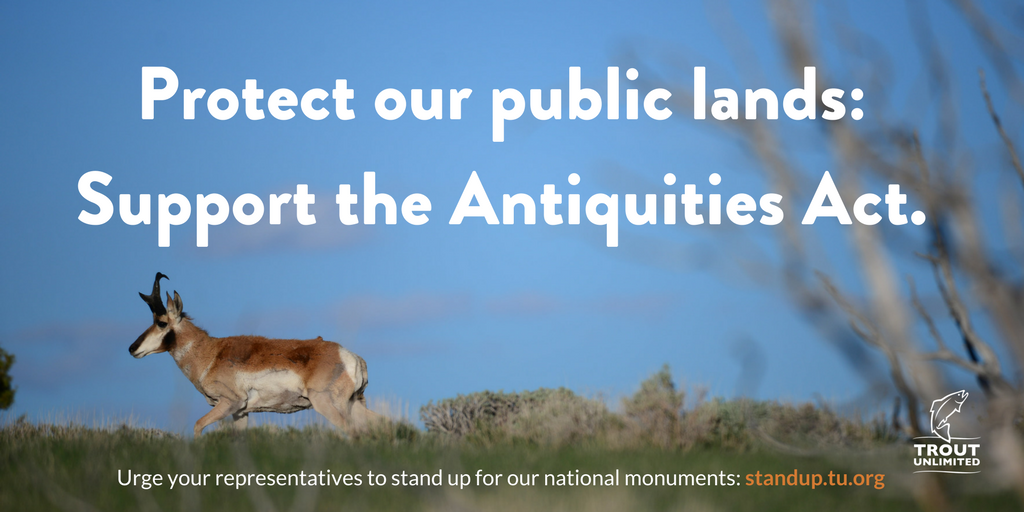By Corey Fisher
The issue of National Monuments and the Antiquities Act tends to elicit passionate responses, both for and against. It also spurs misconceptions.
On October 11, the House Committee on Natural Resources debated and voted to advance H.R. 3990, the National Monument Creation and Protection Act. During the debate many claims were made about National Monuments. Below some clarifications on claims often heard about National Monuments and the Antiquities Act.
But first a little about H.R. 3990:
Proponents of the legislation claim that it creates transparency and gets the Antiquities Act back to what Congress originally intended. The fact is the bill would dismantle the Antiquities Act as we know it and is contrary to how the Act has been used since signed into law by Theodore Roosevelt. H.R. 3990 is an unnecessary overreach that fundamentally undermines the Antiquities Act by attempting to change the very purpose and applicability of the law.
The Antiquities Act is a powerful tool for the conservation of fish and wildlife habitat, and while this tool needs to be used in the right way and in the right place, H.R. 3990 does away with the tool altogether. It does this by narrowing the scope of eligible lands to only those possessing archeological objects, eliminating the ability to use the Act to conserve fish and wildlife habitat, biodiversity, and traditional uses such as hunting and fishing. Moreover, the bill would establish arbitrary limitations on the size of National Monuments and change the law to give presidents new authority to reduce the size of existing National Monuments. Read more about H.R. 3990.
Monumental Myth #1: National Monuments are a land grab.
Fact: Only existing, federally-managed public lands can be designated as National Monuments. These lands already belong to you and I and state or private lands are not included in monument designations. National monuments do not and cannot dictate how private landowners choose to use their lands.
Monumental Myth #2: National Monuments lock out hunters and anglers.
Fact: National Monuments provide some of the best hunting and fishing in the country. Just ask anyone who has fished the Arkansas River through Browns Canyon National Monument in Colorado or drawn a coveted bull elk tag in the Upper Missouri River Break National Monument in Montana. Of the National Monuments in the West currently under review by the Department of the Interior, 100% of the public land available for hunting and fishing before they were designated as monuments is currently open for hunting and fishing after designation – not a single acre was closed. These lands will remain great for hunting and fishing precisely because they are protected as National Monuments. Importantly, most modern monument proclamations explicitly state that fish and wildlife management authority will be retained by fish and wildlife management agencies, just as it was prior to designation.
Monumental Myth #3: The Antiquities Act was only intended to provide for the protection of archeological objects.
Fact: The Antiquities Act has long been used to specifically protect both archeological and natural features, including fish and wildlife habitat. For example, shortly after signing the Antiquities Act into law, Theodore Roosevelt designated Olympic National Monument for the purpose of protecting habitat for the Olympic Elk. For his efforts to protect this species, it was renamed in his honor as Roosevelt Elk.
Monumental Myth #4: National Monuments lock up lands.
Fact: Most National Monuments proclamations honor valid exist rights, such as for oil and gas leases, grazing, and rights-of-way. National Monuments are a flexible type of land designation that can allow for broad access to a variety of multiple uses in ways that are compatible with identified values in need of protection. In essence, national monuments typically keep it like it is, ensuring future access to current uses and activities if they align with the overall purpose of the designation.
Following a designation, site-specific land management plans are created in collaboration with state and local governments, federal agencies, and the public. Input is sought at the beginning of the process, and a draft plan is made available for review and comment before a final decision is made.
Monumental Myth #5: National monuments are created in secrecy without public input.
Fact: The designation of many National Monuments have come after legislative proposals to conserve public lands languished in Congress for years, sometimes decades. In many instances, monuments have been designated only after robust public debate and support from a diverse set of local interests. For instance, when Rio Grande del Norte National Monument was designated in 2013, it received local and statewide support from local elected officials, state and national sportsmen’s groups, grazing permittees, and the New Mexico congressional delegation representing the area.
Monumental Myth #6: National Monuments are the same as a national park.
While some National Monuments have gone on to become America’s most beloved parks, such as Zion and Grand Canyon National Parks, Congress is the body that creates National Parks and it is a decision and action completely separate from the designation of a National Monument. Most modern National Monuments do not become parks and a National Monument can only be redesignated as a National Park if Congress passes legislation to do so. Unlike National Parks, most monuments in the West are managed for multiple use by the BLM or Forest Service. Learn more about different types of land designations.
Monumental Myth #7: National Monuments are supposed to be small.
Fact: Six month after signing the Antiquities Act, Teddy Roosevelt created the first “large” National Monument with the 60,776 acre Petrified Forest. Two years later he set aside 808,120 acres as the Grand Canyon National Monument. Development interests fought the designation and lost in the Supreme Court, establishing the precedent for monuments to protect both large and small areas. Numerous presidents of both political parties have gone on to create National Monuments encompassing large areas with important biological, ecological, historic and cultural values, including hunting, fishing and recreation.
Monumental Myth #8: National Monuments are an unconstitutional abuse of executive power.
Fact: Presidents can create National Monuments only because it is an authority granted by Congress through the Antiquities Act. This delegated authority has been used to create National Monuments by sixteen presidents, eight Republicans and eight Democrats.
From the earliest uses of the Antiquities Act to some of the most recent, Congress had the first opportunity to act on community-driven initiatives intended to conserve important public lands. If Congress does not take action, the president can use the Antiquities Act to try and accomplish the same goals. This approach – using the Antiquities Act to break congressional deadlock – continues to be utilized today.
Monumental Myth #9: National Monuments hurt local economies.
Fact: The outdoor industry accounts for $887 billion in consumer spending and 7.6 million jobs, making it one of the largest economic sectors of the U.S. Local communities near national monuments have leveraged this large and growing sector of the economy to help diversify and build their economies. For instance, following the 2013 designation of Rio Grande del Norte National Monument in New Mexico, tourist visitation to the area increased by 40 percent. Moreover, studies conducted by Headwaters Economics in 2011, 2014 and 2017 found that local economies adjacent to the seventeen National Monuments experienced growth following the designation of the monuments and the studies found no evidence that national monuments stifled economic growth.
Monumental Myth #10: The Antiquities Act is outdated and needs to be reformed.
Fact: Since being signed into law by Theodore Roosevelt, the Antiquities Act has proven to be one of the most successful tools for conservation in American history. Like any tool, it must be used appropriately, but it is important to keep this tool available for those times and places it is needed. Quality hunting and fishing on public lands face many threats, ranging from those who want to sell public lands to proposals that would dramatically cut budgets for managing America’s lands.
With these and many other challenges before us, one thing that hunters and anglers don’t need is Congress to take away one of our most valuable tools for conserving our public lands. Likewise, repealing or diminishing any National Monument would be both legally questionable and a bad precedent which could jeopardize some of our nation’s best habitat and sporting opportunities.
Monumental Myth #11: Presidents can repeal or shrink national monuments.
Fact: When Congress passed the Antiquities Act in 1906, they delegated to presidents the authority to create National Monuments, but did not delegate the authority to reduce or eliminate monuments. In other words, the Antiquities Act is a one-way street.
It makes sense: a designation doesn’t do any good if protections can be stripped on the whim of a future administrations.
While on a handful of occasions past presidents have diminished the size of National Monuments, none have done so since the passage of the Federal Land Policy and Management Act of 1976, which reserved for Congress the authority to modify or revoke National Monuments. Accordingly, Congress can modify or repeal a National Monument as they see fit. Congress is the check on the Executive Branch and is the appropriate venue to address changes to a national monument.
Monumental Myth #12: National Monuments should not be designated because they aren’t funded.
Fact: All types of public lands are chronically underfunded, including National Parks, Fish and Wildlife Refuges, National Forests and BLM lands. This is not an issue unique to National Monuments, this is a problem across the board for our public lands and it is critical that Congress provide the resources necessary for land management agencies to be good stewards.



